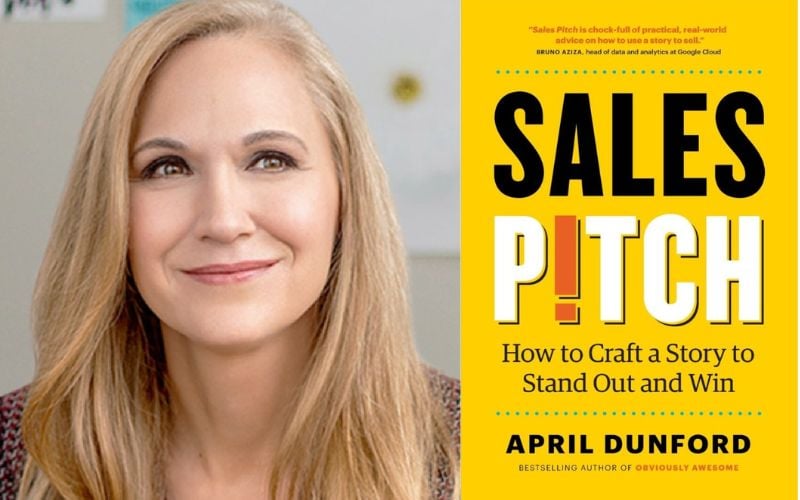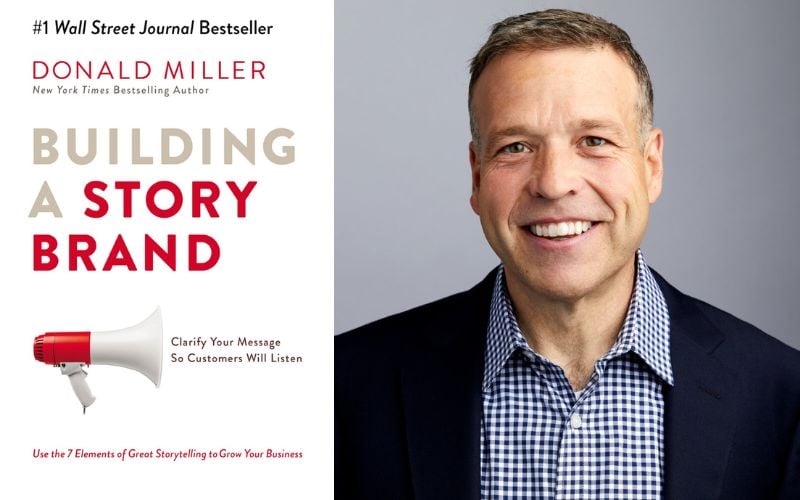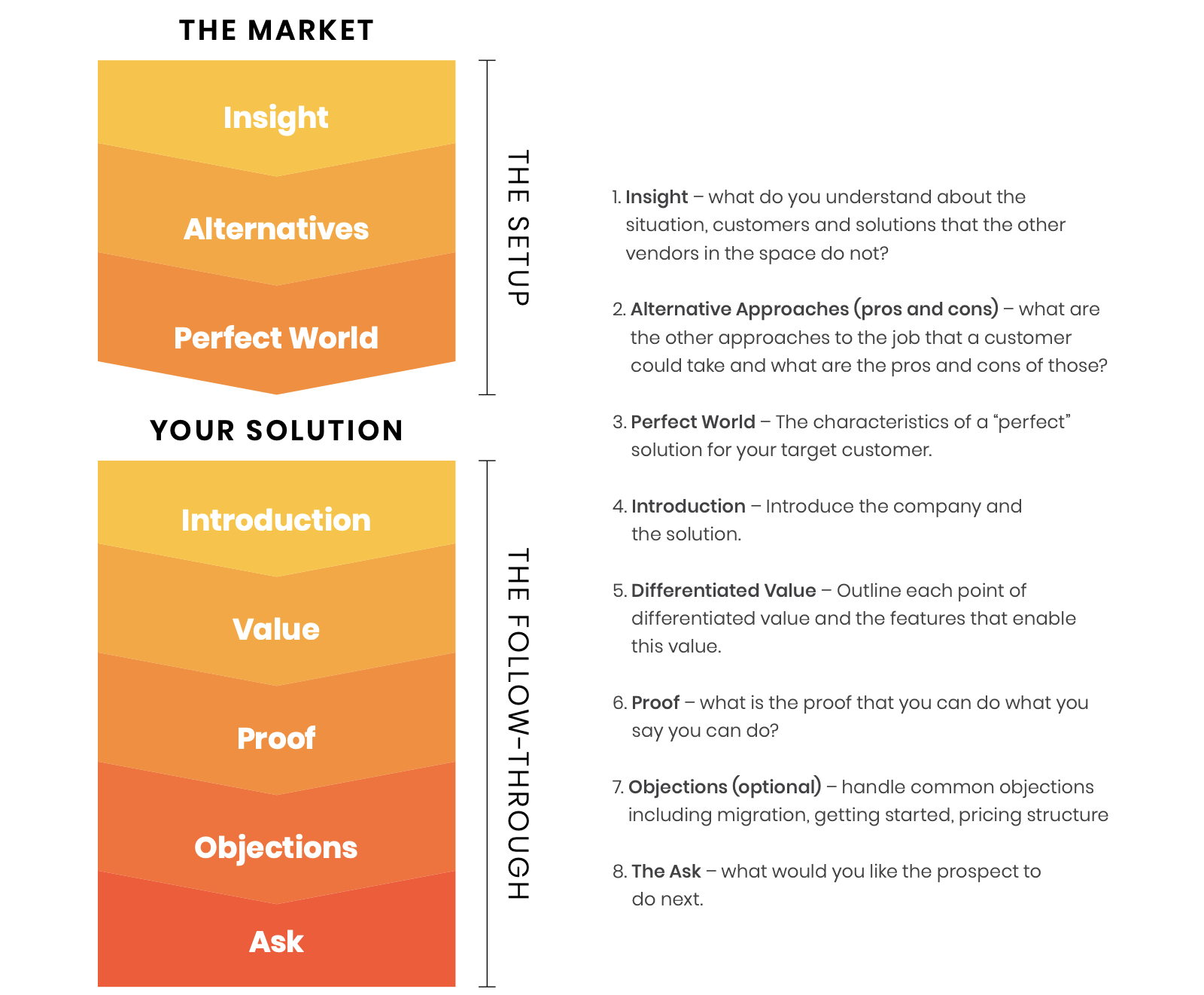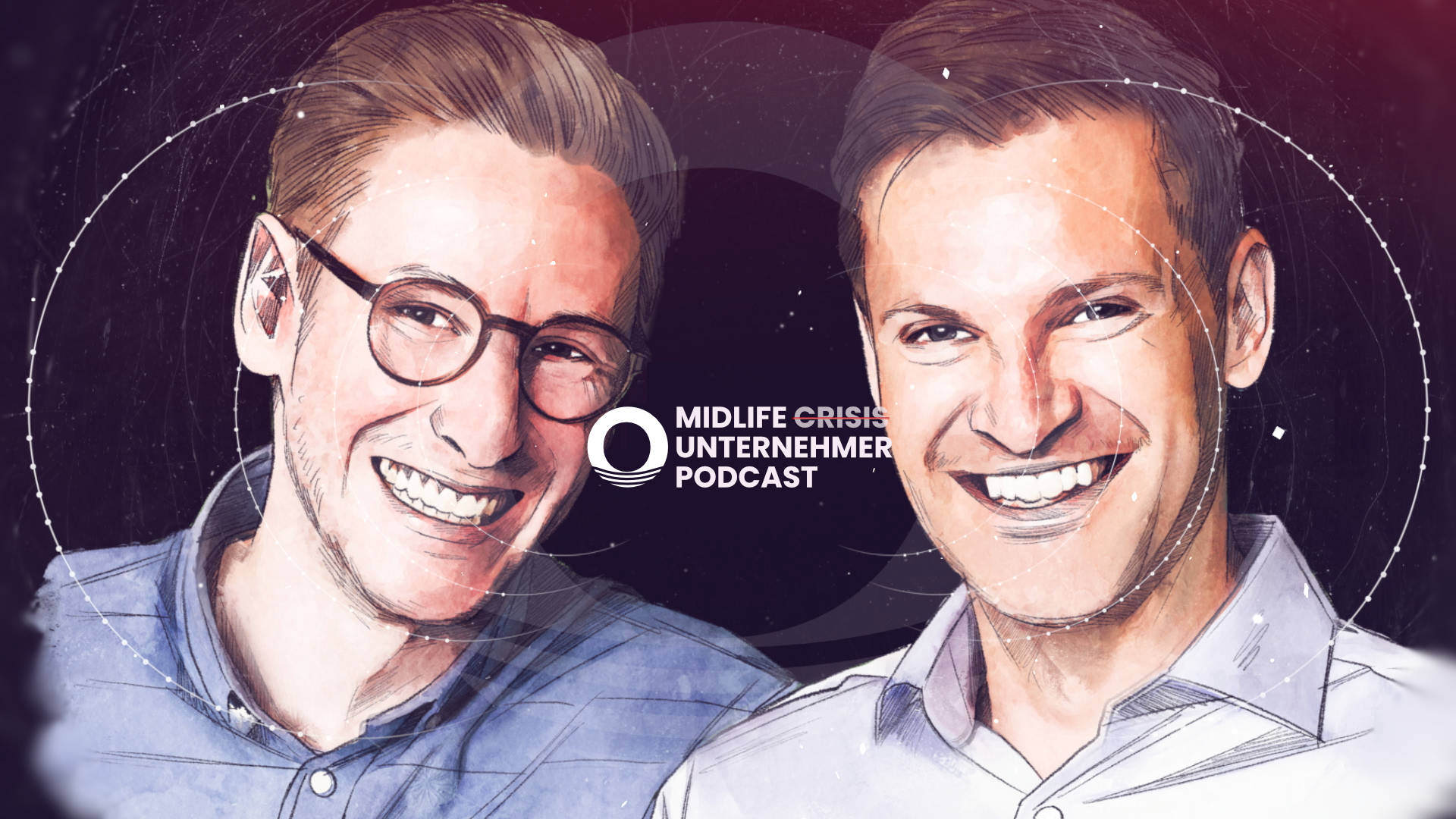Perfect Your Sales Pitch with April Dunford
Without a pitch, there is no sale. Learning how to pitch your services is a business vital. Your pitch can be used not only during sales conversations but also on your website, for your webinars, on your LinkedIn company page and at events. In this article, we look more specifically at April Dunford’s framework from her new book Sales Pitch.
Listen to the podcast:
Comparing Sales Pitch Frameworks: Dunford vs. Miller
When it comes to sales framework, Donald Miller's 'StoryBrand' immediately comes to mind. But which one to follow? Let's dive in and unearth the genius behind both.
Sales Pitch by April Dunford
April Dunford's Sales Pitch Framework is like the insider’s guide to the world of B2B pitching. It begins by gauging the market pulse, understanding the ecosystem, and then identifying that unique perspective about the market that's like a rare gem. What's currently out there? How does it fare? If the world was perfect, what would customers want? With this foundational understanding, the stage is set to introduce your offering. The advantages, the unique value, the irrefutable proof—it’s all laid bare. Plus, with the foresight to anticipate doubts and questions, this framework covers all bases, culminating in that all-important ask: "Are you in?"

Story Brand by Donald Miller
On the other side, we have Donald Miller’s Story Brand Framework, which feels like stepping into an engrossing novel with your customer as the protagonist. This isn't just about selling; it's about storytelling. It sets the scene, introduces the stakes, and unveils the benefits—all while placing your brand as the wise sage guiding the hero (your customer) through their journey. It’s not just about detailing what you do, but painting a vivid picture of how you do it. The approach? Make your customer the hero of their own story and ensure they achieve their happy ending with your solution by their side.

Which Sales Pitch Framework is best?
While both blueprints share an emphasis on clarity, understanding customer pain points, and spotlighting unique solution values, they shine in different arenas. Dunford's Sales Pitch is like a well-researched thesis, comprehensive and analytical, great for those who want a structured and strategic pitch. Meanwhile, Miller's StoryBrand is your favorite narrative, immersing the customer in a tale of triumph and transformation—ideal for businesses that resonate with emotive and experiential pitches.
The real game-changer
It's not just about choosing one over the other—it’s about understanding the essence of both, and tailoring them to your unique business narrative. Because at the end of the day, the pitch isn’t about you. It's about your customers, their needs, their challenges, and how you can be the solution they've been searching for.
Let’s journey on and uncover how the new framework of April Dunford can help you perfect your pitch.
8 Steps to Apply April Dunford's Sales Pitch
The first section is titled 'The Market', and it's all about setting the stage, laying the foundation where the market is clarified within the sales pitch. It's essentially asking, 'Hey, which market are we discussing? Who are our competitors?' How do we position ourselves with our unique perspective? The solution is introduced only in the second part. In essence, it's like laying the foundation first, then building the house on top — a logical progression.

Step 1 – Market Insight
This step revolves around understanding what sets your company apart. What's your unique viewpoint that distinguishes you from others in your market? It's about analysing your competition and effectively articulating your stance—why you perceive things differently. What exclusive insights do you possess about the market that others lack?
From these insights, you can infer your core values, and eventually, the features. But at its heart, it's predominantly about the founder's story. Why does the company exist? What’s the raison d’être of your company? That's the essence of the Market Insight, the initial point discussed in the book.
Implementing the Market Insight
At Cotide, whenever we give our website a facelift, we lean into proven frameworks to get our message just right. This time around, we dialed into April’s approach.
Here’s our take on the Market Insight for our company:
When it comes to finding new customers in the B2B landscape, timing is everything. Businesses make purchases less often due to long-term contracts, extensive setup processes, and the time it takes to learn new systems. This means there’s usually just a narrow window when they’re open to considering alternatives — maybe once every year or sometimes even once a decade.
It’s in these rare and pivotal moments that nailing the right moment to engage with potential customers is crucial. That’s why, especially in the B2B world, timing isn’t just everything; it’s often the only thing. Successful companies can identify the right timing regularly, start meaningful conversations that allow them to showcase their expertise, and position themselves as the go-to expert.
Step 2 – Alternatives
This is where we size up the competition. You've probably heard the old adage, 'Never badmouth the competition.' But April challenges that notion. She emphasizes the need to boldly highlight what you do better than the rest. It's about pinpointing where those traditional legacy companies are headed versus the trajectory of your innovative business. Lay out the pros and cons of each alternative, making sure your business stands out in all its glory.
Implementing the Alternatives
In our corner, the alternatives are pretty black and white: hiring some new talent like an SDR or doing nothing and keeping things as they are.
Some of our potential clients confidently declare, 'We'll hire a sales superstar!' or an SDR who’s going to cold-call the world and blitz out emails like there's no tomorrow. But here's the catch: hiring and training isn't just pricey, it's like throwing darts blindfolded. You miss out on knowing when leads are ripe for the picking, and end up with a sales team that’s just winging it.
Many people tend to stick to the old ways, even if they're watching them crash and burn, all for the sweet comfort of control. Dive into the familiar, even if it's a sinking ship, just because it's, well... familiar.
So, here’s the bottom line: some would rather shell out a year's salary on someone they hope is 'making waves' instead of diving into fresh, exciting waters. Others? They’re playing the waiting game, convincing themselves they’ve got all the time in the world. 'No rush', they say, 'Maybe next quarter...'"
Step 3 – Perfect World
Having laid out your unique perspective on the market in the 'Market Insight' stage, and then exploring the alternatives, the next step is to paint a picture of the 'Perfect World'. This is where you vividly describe the ideal solution for your customer.
Implementing the Perfect World
In our ideal 'Perfect World,' we imagine a seamless, automated process that consistently fills your pipeline with high-quality leads. Leads are nurtured individually and personally at scale and moved along your sales funnel until they mature and are ready to buy. We believe in steering our own ship, not relying on luck. That’s why the perfect world allows for a robust system that gets results.
Step 4 – Introduction of the Company and Solution
In this crucial step of the April Dunford's Sales Pitch Framework, it's time to introduce your company and present the solution to the problem that you have previously identified. This is the moment to showcase your expertise and demonstrate how your offering can address the unique challenges faced by your target audience.
Implementing the Introduction of the company and solution
We thrive on transforming cold leads into loyal customers. Imagine leads who've never heard of you today, becoming well-acquainted and, with perfect timing, converting to your company. Our AI makes this possible, crafting personalized customer journeys for thousands of customers simultaneously.
Step 5 – Differentiated Value
Now, let's focus on the most crucial aspect: what sets you apart? What unique value do you offer compared to other solutions? Many companies make the mistake of jumping right into their features, but here, it's all about emphasizing the value, with the enabling features subtly complementing it in the background.
Implementing Differentiated Value
Our unique value proposition includes the ability to identify the perfect timing, engage in meaningful conversations with potential clients, strengthen your positioning in the market, and expand your reach to a wider audience.
Identifying the Right Timing
In today's fast-paced and competitive business landscape, timing is everything. The ability to identify the perfect timing is what sets successful companies apart from the rest.
Imagine having the ability to identify those prospects who are not just aware of their problem and the potential solution, but are also actively seeking a solution. These are the golden leads that every business dreams of, the ones who are primed and ready to make a purchasing decision.
But how does one identify the right timing?
Enabling Feature for Knowing the Timing
Our solution includes a user-friendly dashboard that allows you to easily determine which leads are on the verge of taking action, are ready to make plans and consider purchasing. The dashboard relies on the prospect's responses to an interactive industry survey, which we build for each of our clients. Participation in the survey is boosted by the ability of the respondent to benchmark themselves in real time and to get personalised recommendations.
Starting conversations with potential clients
Starting conversations with potential clients is a crucial step in the sales process. It allows you to build relationships and establish yourself as a trusted advisor. By being proactive in sharing your expertise and knowledge, you can create meaningful connections that lead to long-term customer relationships and, ultimately, sales success.
Enabling Features for starting conversations
One way to start conversations with potential clients is by reaching out to them through personalized messages. The key is to tailor your message to their specific needs and pain points. Our hyper-personalised icebreakers and openers do exactly that at scale. With our solution, you can show thousands of leads that you understand their challenges and so get the conversation going. This feature is enabled by our extensive lead research and enrichment process, which takes place in the onboarding process.
Strengthening your positioning and extending your reach proactively
One of the most effective ways to strengthen your positioning in the market and extend your reach is by sharing your expertise and knowledge proactively with your target audience through various channels.
Enabling Features for Positioning
Our solution helps you collect data and publish an industry report about and for your market. The survey and resulting report allow you to position your company as an industry leader instead of a follower. The report delivers fresh and unique insights you can share via email, on LinkedIn, during a webinar and on your podcast.
Enabling Features for Reach
The extensive lead research process included in the onboarding combined with our ability to send and deliver personalised email campaigns at scale allow our clients to increase their reach massively and sustainably. After sending over 100k cold emails in 2023 only, we've become experts in optimising deliverabiliy and crafting emails that get opened and clicked. We also advise our clients on how to boost their LinkedIn presence and updates.
Step 6 – Proof
Now that you have proclaimed your differentiated value, it's time to back it up with proof. This step is crucial in establishing credibility and trust with your target audience. By providing evidence and testimonials, you can demonstrate that your solution is effective and has delivered results for others.
Implementing Proof
At Cotide, we understand the importance of proving our differentiated value to potential clients. We have a track record of success and a portfolio of satisfied customers who have benefited from our solution. Here are some ways we solidify our proclaimed differentiated value with proof:
Case studies: We showcase real-life examples of how our solution has helped businesses find new customers through the survey, extend their reach through LinkedIn, press inquiries, webinar and podcast invitations, and strengthen their positioning with the insights from the report.
Testimonials: We gather feedback and testimonials from our clients, capturing their experiences and satisfaction with our solution. These testimonials serve as social proof, demonstrating that our solution is trusted and endorsed by others in the industry.
Data and metrics: We present data and metrics that demonstrate the effectiveness of our solution. This includes key performance indicators such as:- Email open rate: 60%
- Email click rate: 40%
- Survey completion rate: 15%
- LinkedIn reach: +50%
- Number of cold leads at start: 2000 to 4000
By incorporating these elements of proof, we solidify our proclaimed differentiated value and build trust with potential clients. We understand that making bold claims is not enough; we need to provide evidence that supports our value proposition.
Step 7 – Objections
Objections are inevitable in sales, ranging from concerns about price to unexpected issues during a demo or conversation. Addressing objections proactively is crucial, according to the April Dunford's Sales Pitch Framework. It allows for engagement, trust building, and demonstrating care for the customer's needs.
To effectively handle objections, listen attentively, empathize, acknowledge, and validate the customer's perspective. This approach shows understanding and a willingness to address concerns head-on.
Implementing Objections
The main obstacle that arises when selling our solution is the allocation of resources, both in terms of time and money.
We understand that clients may be hesitant to invest their valuable resources. To address this concern, we emphasize our highly structured process, which requires only two 90-minute workshops. The remaining workload is handled by our team, as we pride ourselves on providing exemplary service.
Additionally, we accommodate clients who may not be ready to proceed immediately, offering flexibility and understanding. For instance, if a client feels the need to first revise their website or onboard a new sales development representative (SDR), we are willing to adjust our timeline accordingly. We recognize that businesses often have various projects and priorities, particularly mid-market companies with small marketing teams. Our aim is to alleviate any sense of overwhelm and work collaboratively to find the optimal timing for implementation.
Step 8 – Call to Actions
After handling objections, guide your prospects to the last step with a clear call to action (CTA). Connect the CTAs seamlessly to the content, making it easy for prospects to take the next logical step. Provide accessible actions that align with the content they've consumed. Whether it's signing up for a free trial, scheduling a demo, or subscribing to your newsletter, make the CTA compelling, concise, and guiding. A clear and enticing CTA maximizes engagement, conversions, and leads to loyal and satisfied customers.
Implementing CTAs
Here are some ways we engage with potential clients and guide them towards the next step:
- On LinkedIn: we ask them to leave a comment or message expressing their interest and desire to connect further.
- In emails: we encourage recipients to fill out a survey related to the email topic, allowing them to provide valuable feedback.
- In our podcast: we encourage listeners to subscribe to stay updated on future episodes and valuable insights.
- In our webinars: we offer the opportunity to arrange a one-on-one call without any obligation, providing a personalized experience and addressing specific needs.
- In demos, we try to schedule a follow-up call to further discuss their requirements and provide additional information.
It's important to note that these actions are not immediate purchases. In the B2B tech environment, there are often multiple steps and considerations before making a final decision. These engagement strategies serve as pre-product steps, guiding potential clients towards a deeper understanding of your solution and eventually leading to a purchasing decision.
About April Dunford
April Dunford is an internationally recognized expert in positioning and market strategy. With over two decades of experience as an executive in successful technology startups and global tech giants like IBM and Huawei, she has a deep understanding of how businesses can stand out in crowded markets. Author of the critically acclaimed book "Obviously Awesome," and more recently “Sales Pitch”, April is passionate about helping companies frame their products in a way that resonates with customers and drives explosive growth.
Share this
You May Also Like
These Related Stories

The GTM Strategy: Demand Re-Routing Solves Your Pipeline Problem

Unlock Sales: The Small Business Guide to B2B Conferences
